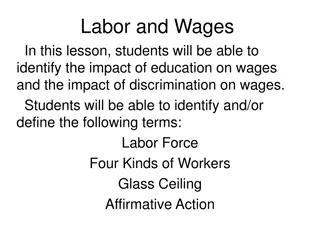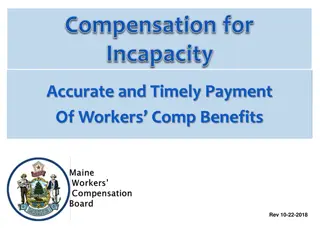Understanding Average Weekly Wages in Maine Workers' Compensation Act
Average Weekly Wage calculations under the Maine Workers Compensation Act are crucial for determining benefits for injured employees. The Act provides different methods based on regular, irregular, and seasonal employment to estimate what the employee would have earned if not injured. These calculations ensure fair compensation by considering various factors such as consistent earnings, salary, and workdays. Applying the designated methods in order helps determine a fair and reasonable Average Weekly Wage for injured workers.
- Average Weekly Wage
- Maine Workers Compensation Act
- Wages Calculation
- Injured Employees
- Compensation Benefits
Uploaded on Sep 16, 2024 | 1 Views
Download Presentation

Please find below an Image/Link to download the presentation.
The content on the website is provided AS IS for your information and personal use only. It may not be sold, licensed, or shared on other websites without obtaining consent from the author. Download presentation by click this link. If you encounter any issues during the download, it is possible that the publisher has removed the file from their server.
E N D
Presentation Transcript
Calculating Average Weekly Wages Rev 5-2-2017
What is Average Weekly Wage? Our statutory scheme provides a method of predicting what the employee would continue to earn had no injury occurred. Landry v. Bates Fabric Inc. Our workers compensation system seeks to estimate what the employee would be earning during the time of his disability were he not injured. Coffin v. Hannaford Bros. Co. Fair and reasonable
Maine Workers Compensation Act, Section 102(4) A. Regular workweek and consistent earnings, or salary B. Irregular workweek, or employed less than 200 workdays C. Seasonal employment D. Everybody else
Three pigeon holes and a black hole Apply each method - 102(4)(A), (B), and (C) - in order. If one does not apply, or does not produce a fair and reasonable AWW, move to the next one. If neither A, B, nor C produce a fair and reasonable AWW, use 102(4)(D).
Section 102(4)(A) the amount that the employee was receiving at the time of the injury for the hours and days constituting a regular full working week Regular workweek with consistent earnings, or paid a salary Must have worked at least 200 full working days
Section 102(4)(A) AWW = weekly pay (salary, etc.) at time of injury Not applicable to employees whose wages during that year have generally varied from week to week move to subsection B
Section 102(4)(B) Use for employees whose wages during that year have generally varied from week to week -OR- When the employment or occupation did not continue pursuant to paragraph A for 200 full working days
Section 102(4)(B) AWW = the entire amount of wages or salary earned by the injured employee during the immediately preceding year divided by the total number of weeks, any part of which the employee worked during the same period
Section 102(4)(B) Do not include earnings from week-of- injury if they reduce the AWW Do not include earnings from week-of- hire if they reduce the AWW Do not include weeks with no earnings
Section 102(4)(C) Employment based on the seasons
Section 102(4)(C) Notwithstanding paragraphs A and B, the average weekly wage of a seasonal worker is determined by dividing the employee's total wages, earnings or salary for the prior calendar year by 52
Section 102(4)(C) Includes any employee who is employed directly in agriculture (see 102(2)) or in the harvesting or initial hauling of forest products (loggers and log haulers), regardless of weeks worked, and All others who work (seasonally) no more than 26 weeks per year
Section 102(4)(C) AWW = gross earnings for prior calendar year divided by 52 weeks o Include earnings from all employment o Do not use if employee was not seasonal in prior calendar year
Section 102(4)(C) Seasonally employed examples: Ski instructor Lifeguard Waiter/waitress at seasonal restaurant Cook at summer camp Cashier at seasonal amusement park
Section 102(4)(D) For those situations where (A), (B) or (C) can not be reasonably and fairly applied Commonly referred to as the fallback provision
Section 102(4)(D) AWW = ? (you decide) Consider the previous wages, earnings or salary of the injured employee and of other employees of the same or most similar class working in the same or most similar employment in the same or a neighboring locality
Section 102(4)(D) Consider employee s past wages Consider wages of at least 2 comparable employees Use your own judgment to calculate an AWW that is fair and reasonable You may want to consider obtaining a WCB-4A Consent
Maine Workers Compensation Act, Section 102(4) A. Regular workweek and consistent earnings, or salary B. Irregular workweek, or employed less than 200 workdays C. Seasonal employment D. Everybody else
Section 102(4)(E) Concurrent Employment Calculate AWWs from each employer and add them together Need not use the same method to calculate AWW for all employers (see Harrigan v. Maine Veterans Home) Employment relationship must exist at the time of the injury (see Plourde v. Plourde)
Section 102(4)(F) Expenses Reimbursement of expenses incurred by the employee in the course of his/her employment are not included in AWW Examples: mileage reimbursement, meals, tolls, lodging, etc. incurred by employee and reimbursed by employer
Section 102(4)(G) Prior Injuries The fact that the employee suffered a previous injury does not preclude compensation for a later injury or death In determining compensation for the later injury, the employee s AWW will represent the earning capacity at the time of the later injury, in the employment he/she was working at that time (unless the prior injury affects the later employment)
Section 102(4)(G) Prior Injuries (continued) In calculating the AWW for the subsequent injury, be sure to exclude any weeks in which the employee received workers compensation benefits from the prior injury Those weeks with WC payments should be on the wage statement, with a note that they were excluded in the AWW calculation
Section 102(4)(H) Fringe Benefits Examples of fringe benefits include health insurance, 401-Ks, and employer- provided meals, housing, and cars. See Rule 1.5. Fringe benefits that continue to be paid by the employer are not included in AWW calculation Form WCB-2B Fringe Benefits Worksheet
102(4)(H) - Fringe Benefits (continued) Any fringe benefits that do not continue to be paid by the employer during the disability must be included in AWW calculation but - Those fringe benefits are only included to the extent that their inclusion will not result in a weekly benefit greater than 2/3 of the SAWW at the time of injury
102(4)(H) Fringe Benefits (continued) Partial Benefit calculation steps: 1. Use AWW with fringes to calculate benefits due (benefit amount cannot exceed 2/3 of the SAWW at the time of injury) 2. Use AWW without fringes to calculate the benefits due (cannot exceed current max rate) 3. Compare the benefits above and pay the greater of the two amounts calculated above
Other AWW issues - Bonuses Generally includable if performance based and/or part of the pay package Examples of includable bonuses: Sales or production based incentives Commissions Safe driving bonuses for truckers Annual profit sharing or Christmas bonuses One time bonuses and awards generally not includable
Other AWW issues - Pre-paid vacation time Pre-paid vacation time is includable in AWW calculation to the extent it is used in the 52-week period covered by the wage statement Example: Employee receives 4 weeks pre-paid vacation pay for the year on January 2 EE uses a week in January and a week in February EE injured in April and out on TTD Include 2 of the 4 weeks on the wage statement to cover the zero weeks in January & February Explain in the comments section
Other AWW issues - Change in employment status AWW should reflect weekly earning capacity of the injured employee in the employment in which the employee at the time of the injury was working. Factors such as promotions, demotions, change from part-time to full-time (or vice versa) may affect AWW calculation Use only those wages after the change in status Still fill in all weeks, note calculation method in comment section
Other AWW issues - Payment in lieu of benefits Examples: Employee receives an extra $5.00 per hour to purchase optional benefits, but chooses not to purchase them Employee opts out of health care plan and is paid a monthly amount regardless of hours worked These payments would be included on the wage statement as wages, not on the fringe benefit worksheet as fringes
Other AWW issues - Tipped Employees Earnings for tipped employees, such as servers, bartenders, taxi drivers, etc., include tips. Reported tips must be included on the Wage Statement as earnings. Example a waitress works 40 hours at $3.75 per hour and reports tips of $200.00 for that week. The wage statement should show earnings for the week of $350.00 (40 hours at $3.75=$150, plus $200 of reported tips). Claim administrators should be verifying the inclusion of reported tips when submitting the Wage Statement.
Calculating Average Weekly Wages Questions???























